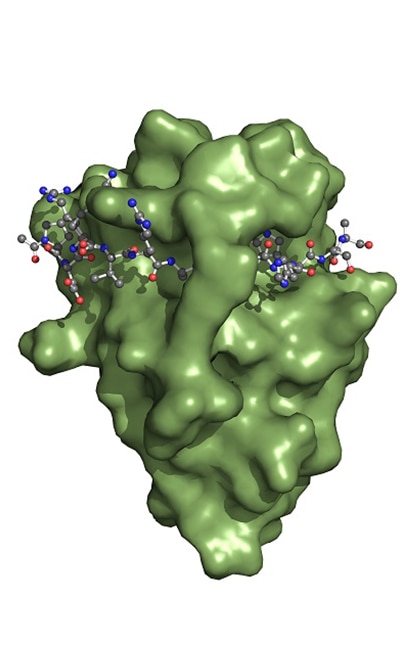
Spot Capture and
Detection System
For immunoprecipitation, protein purification & immunofluorescence
ChromoTek’s proprietary and novel Spot-Tag system is the first peptide-tag specific Nanobody for universal capture & detection applications. It comprises the Spot-Tag®, an inert 12 amino acid peptide-tag (PDRVRAVSHWSS), and Spot-Nanobodies that specifically bind to Spot-tagged proteins with high affinity.
Applications & Tools:
- Immunoprecipitation (IP) / Co-IP: Spot-Trap®
- Co-IP /MS: Spot-Trap and iST Spot-Trap Kit
- Protein purification: Spot-Cap®
- Immunofluorescence: Spot-Label®
- Western Blotting: Spot-tag antibody [28a5]
Affinity Optimized Short Peptide Tag
The Spot-Tag® has been engineered from a linear epitope on the unstructured N-terminus of beta-catenin resulting in the affinity optimised 12 amino acid sequence; PDRVRAVSHWSS. The inert tag can be added to the N-terminus and/or the C-terminus of the protein of interest using modified Spot-Tag® coding primers, or the Spot vectors offered (see ‘Cloning information’ tab below). The expression of Spot-Tagged proteins has been successfully tested in bacteria, yeast, mammalian cell lines, plant and insect cells.
- More robust & stable than IgG antibodies
- High affinity of 6 nM to Spot-tagged proteins and 0.7 nM to Spot-Tag
- Less background than other tested affinity resins
- Less unspecific binding than other tested capture and detection antibodies
- Higher resolution than conventional antibodies
- Better epitope accessibility and tissue penetration than conventional IgG antibodies
- Effective and gentle elution at 4°C (Spot-Cap)
Spot-Tag advantages compared to other peptide tags:
- Less negatively charged than FLAG®-, Myc-, and HA-tags
- Short
- Inert, unstructured tag does not interference with fusion protein structure and function
- Binding of a single tag
- Suitable for ubiquitination assays: comprises no lysine
The Spot-Nanobody, also termed Spot VHH, is a single-domain antibody derived from the alpaca heavy-chain only antibody raised against the Spot-Tag® peptide. The Spot-Nanobody recognizes the Spot-Tag® sequence motif PDRVRAVSHWSS. Binding occurs when the Spot-Tag® peptide is embedded on the surface of the Spot-Nanobody and acts like a β-sheet extension. Specificity is determined by interactions of the Spot-Nanobody’s side chains to the Spot-Tag peptide. Notably, the bound Spot-Tag® is clamped by two amino acid side chains of the Spot-Nanobody explaining its high affinity (0.7 nM). The Spot-Nanobody binds Spot-tagged proteins present at heterologous, and/or endogenous expression levels with minimal cross-reactivity with beta-catenin.
Experimental data from immunoprecipitation and immunofluorescence experiments show that the beta-catenin background, i.e. binding of beta-catenin to the Spot-Nanobody is negligible. However, for very sensitive methods such as Mass Spectrometry, binding to beta-catenin-binding may be still detectable, as well as to some of the beta-catenin interaction partners such as alpha-catenin. Since these are known contaminants, these peptides can be easily subtracted during data analysis or used for alignments. Additionally, our data indicate that Spot-Trap only binds to beta-catenin, if this epitope is dephosphorylated, which reduces background levels even further.
Spot-Nanobody is fully validated
- Recombinantly produced for constant high quality
- Sequence known
- Structure determined
- Binding mechanism understood
Spot-Nanobody is better performing in many capture and detection applications than other antibodies. Most of these antibodies are conventional IgGs, which may suffer from stability and size. Spot-Nanobody however is small size to better access the Spot-Tag epitope. In addition, Spot-Nanobody is very stable and binds to Spot-Tag even under harsh conditions. Non-IgG type affinity reagents for affinity-tags can’t be used for detection and imaging of tagged proteins, whereas Spot-Nanobody has an outstanding performance in immunofluorescence and Western blotting. Spot-Nanobody is the first Nanobody/ peptide-tag that was applied in super-resolution microscopy.
Key Features
- Small size of just 14.7 kDa or 2 nm
- High affinity binding of Spot-Tag with KD = 0.7 nM
- High chemical and thermal stability
- High chemical and thermal stability (Tm = 65.1 °C)
- No contaminating heavy & light antibody chains
- Native elution with Spot-peptide & by pH shift
- Matrix can be regenerated
- Optimized Nanobody for gentle elution at 4°C
Key Benefits
- Specific binding with low background
- Robust handling and stable in harsh conditions
- Native & non-native elution
- Highly specific binding
- Higher resolution
- Good epitope access & sample penetration
- Good detection limits
- Validated
- Effective purification of Spot-tagged proteins
For ease of cloning, we offer a range of Spot vectors:
Spot-Tag Vectors for cloning
Spot-Tag Vectors - positive control
For additional cloning strategies see below suggestions for codon-optimized sequences and linkers:
Amino acid sequence Spot-Tag
PDRVRAVSHWSS
Position Spot-Tag
N-terminus and C-terminus
Codon optimized sequences for Spot-Tag
E. coli
CCG GAT CGC GTG CGC GCA GTC TCT CAC TGG AGC AGC
D. melanogaster
CCC GAT CGC GTG CGT GCC GTG AGC CAC TGG AGC TCG
S. cerevisiae
CCA GAT AGA GTT AGA GCT GTT TCT CAT TGG TCT TCT
Human cell line
CCA GAC CGC GTG CGC GCC GTG AGC CAT TGG AGC AGC
A. thaliana
CCT GAT AGA GTT AGA GCT GTT TCT CAT TGG TCT TCT
Linker (optional)
We recommend a short Gly-Ser linker if there are adjacent acidic amino acids (Glu/Asp):
E. coli GGT TCT
S. cerevisiae GGT TCT
Human cell line GGC AGC
For more details about the Spot-Tag system, click here.
Explore Spot Capture and Detection Tools
Interaction of Spot-Nanobody (green) with Spot-Tag peptide (gray sticks coloured by element)
| Product | Formats (Product citations in parentheses) |
|---|---|
| Spot-Cap | Agarose beads |
| Spot-Label® | ATTO488, ATTO594, Alexa Fluor® 488, Alexa Fluor® 568, Alexa Fluor® 647 |
| Spot-Trap® | Agarose (3), Magnetic Agarose (6), Magnetic Particles M-270 |
| Spot VHH | Unconjugated |
| Spot-Tag® antibody (28A5) | Unconjugated |
| Spot-Tag Vectors for cloning | ev-1, ev-2, ev-3, ev-4, ev-5, ev-6, ev-7, ev-8 |
| Spot Vectors - positive controls | ev-31, ev-32, ev-33 |